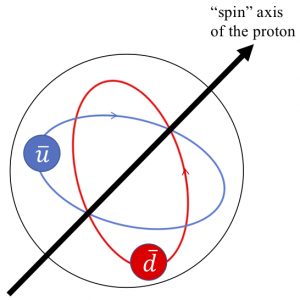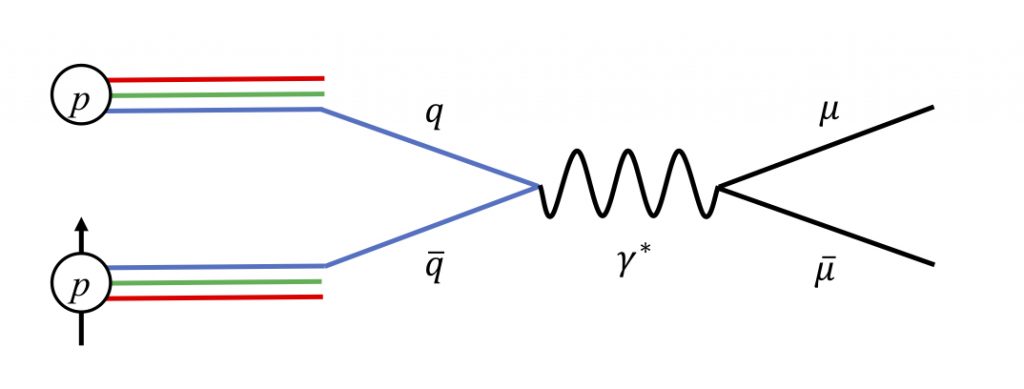Main goal of SpinQuest
Every proton and neutron is made up of tinier particles called quarks and gluons, and we continue to explore how the quarks and gluons behave therein. Both quarks and their anti-matter cousins the anti-quarks play a role in creating protons and neutrons. The SpinQuest experiment is designed to explore a very particular aspect of proton and neutron structure: Are the sea quarks orbiting around the spin axis of the nucleon?

The interesting details
At the heart of every atom is a nucleus, and every nucleus is constructed from just two particles; the proton and the neutron. Collectively, we call the proton and neutron “nucleons” since they are the residents of every nucleus. Nucleons are themselves made up from another set of particles called quarks and gluons.
If you wanted to build a proton from scratch, for example, you would need two “up” quarks (uu) and one “down” quark (d). As soon as you put those three quarks together, a very strong attractive field of gluons would bind them together. The field of the gluons is very strong indeed; most of the mass of the proton comes from the field of gluons, and not from the quarks themselves.
The quarks have electric charges, by the way; up-quarks have +2/3 charge (measured in units of the electron charge) while down-quarks have a -1/3 charge. However, the electric force is NOT responsible for the main attraction felt between the quarks; the gluon field creates a force thousands of times stronger that binds the quarks together.
Another thing that happens, after you put the three quarks together and the gluon field is created, is the gluons create pairs of quarks and anti-quarks! For example, a pair of up (u) and anti-up (u) quarks might be created. This is possible because the field of the gluons contains a lot of energy, more than enough energy to create these particle pairs, and the up- and down-quarks have very little mass. These quark and anti-quark pairs do not exist for very long, and they eventually recombine to create a gluon, but a lot of them are created and on average they have a presence in the nucleon that cannot be ignored. We call the quarks and anti-quarks created in this way the “quark sea” — an ocean of additional quarks created by the gluon field.
To complete our picture of the nucleon, we have to mention that the constituent particles, the quarks and gluons, have an interesting property called “spin”. We call this property “spin” because particles with “spin” appear to be rotating, but it is not like a top spinning; there is no actual rotation involved. Yet this “spin” has real consequences; if a particle with “spin” has electric charges in it, then the “spin” will create a magnetic field!
Now we come to the main point. The proton and neutron each have “spin” and an associated magnetic field. A great mystery that is not understood: How do the quarks and gluons inside the nucleon create this state of “spin”? In total, the “spin” of the nucleon must arise from a combination of the “spin” of the quarks, anti-quarks, and gluons, as well from orbital motion of those same particles about the center of the nucleon. It has been determined from other experiments that the “spin” of the nucleon does not arise solely from the “spin” of the quarks and anti-quarks. SpinQuest will investigate whether the sea quarks are orbiting around the center of the nucleon by exploring the nucleon in a particular way.
A beam of protons is created by an accelerator at Fermilab, called the Main Injector, and this beam of protons is directed at a target also containing protons. The protons in the target, however, are arranged so that the axis of the “spin” of most of the protons point all in the same direction; we say the protons in the target are “spin polarized” and we say we have a “polarized target.” When the protons in the beam interact with the protons in the target, we look for a special process where a quark in the beam proton and an anti-quark in the target proton combine to form a single particle of light, a photon. This is a special kind of photon that is unstable and does not travel very far, and it quickly decays into another particle and anti-particle pair. This special process is called the Drell-Yan process, after two scientists who figured out it must be going on in such collisions of protons. We look for the particle and anti-particle pair (in our case we look for a muon–anti-muon pair) in a special detector constructed just for this purpose, and we study the relationship between the angles at which those particles were emitted compared to the direction in which the target is polarized; this reveals key information about how the quarks and anti-quarks are behaving inside the protons.

